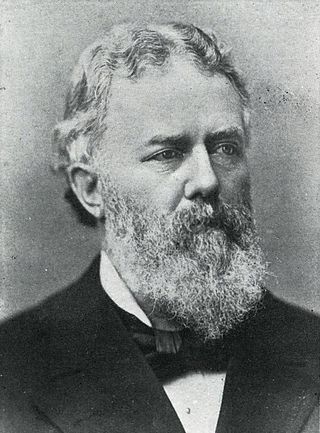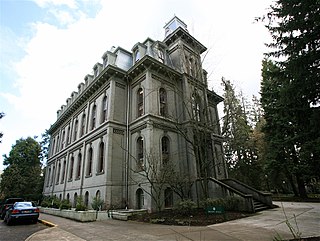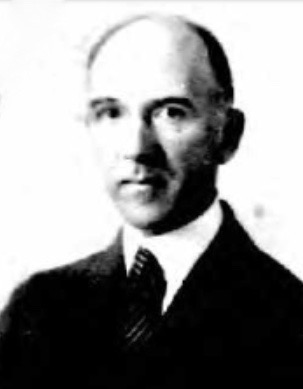
The University of Oregon is a public research university in Eugene, Oregon. Founded in 1876, the university also has a satellite campus in Portland; a marine station, called the Oregon Institute of Marine Biology, in Charleston; and an observatory, called Pine Mountain Observatory, in Central Oregon.

Alexander Phimister Proctor was an American sculptor with the contemporary reputation as one of the nation's foremost animaliers.

The Oregon Ducks are the intercollegiate athletic teams that represent the University of Oregon, located in Eugene. The Ducks compete at the National Collegiate Athletic Association (NCAA) Division I level as a member of the Pac-12 Conference. With eighteen varsity teams, Oregon is best known for its American football team and track and field program, which has helped Eugene gain a reputation as "Track Town, USA". Oregon's main rivalries are with the Oregon State Beavers and the Washington Huskies.

Matthew Paul Deady was a politician and jurist in the Oregon Territory and the state of Oregon of the United States. He served on the Oregon Supreme Court from 1853 to 1859, at which time he was appointed to the newly created federal court of the state. He served as a United States district judge of the United States District Court for the District of Oregon in Portland, as the sole Judge until his death in 1893. While on the court he presided over the trial that led to the United States Supreme Court decision of Pennoyer v. Neff concerning personal jurisdiction.

University Hall, formerly Deady Hall, is a historic building located in Eugene, Oregon, United States. It was built from 1873 to 1876 by W. H. Abrams to a design by architect William W. Piper. It was the University of Oregon's first building, and remained the university's only building for almost ten years after its construction. After the university gained other buildings, it was known simply as the "Old Building", but in 1893 it was renamed "Deady Hall" in honor of Matthew Deady, Oregon's first federal judge. Ironically, Deady believed that state universities were of little use to anybody, and in 1857, during the Oregon Constitutional Convention, Deady moved to strike the section authorizing a university from the Oregon State Constitution. His efforts were initially successful, although by the 1870s a state university had become inevitable, and the building that bears his name was constructed in spite of Deady's earlier objections. In another twist of fate, Deady was first president of the university's Board of Regents.

The campus of the University of Oregon is located in Eugene, Oregon and includes some 80 buildings and facilities, including athletics facilities such as Hayward Field, which was the site of the 2008 Olympic Track and Field Trials, and McArthur Court, and off-campus sites such as nearby Autzen Stadium and the Riverfront Research Park. An online guide to the university's built environment, Architecture of the University of Oregon, published by the University of Oregon Libraries, describes campus buildings and provides timelines of key architectural events linked with campus history.
The Oregon Ducks baseball team represents the University of Oregon in NCAA Division I college baseball in the Pac-12 Conference. The home games are played on campus at PK Park.

University and Villard Halls, University of Oregon are historic academic buildings on the campus the University of Oregon in Eugene, Oregon. Built in 1876 and 1886 respectively, they are among the oldest surviving academic buildings on the west coast of the United States, and are noted for their Second Empire architecture. They were designated a National Historic Landmarks as a pair in 1977.
The University of Oregon has a diverse array of student-run and non-student-run media outlets.
The Pacifica Forum was a discussion group in Eugene, Oregon, United States. It was hosted by retired University of Oregon professor Orval Etter. It culminated a long slide into extremism by ceasing operations after Etter's death and has not been reconstituted.

Henry Waldo Coe was a United States frontier physician and politician.
Football teams at the University of Oregon have played home games at six sites since the team was founded in 1894, five in Eugene and one in Portland. Oregon has not had an on-campus football stadium since 1966.
Michael Harry Schill is an American legal scholar and academic administrator currently serving as the 17th president of Northwestern University since September 2022.

The Pioneer Mother is a sculpture formerly located on the University of Oregon campus in Eugene, Oregon. Burt Barker donated the six-foot-tall bronze sculpture, created by artist Alexander Phimister Proctor, to the university. Barker's daughter, Barbara Barker, introduced the sculpture to a public gathering of hundreds on May 7, 1932, during Junior Week and Mother's Day festivities.

Akbar's Garden is an outdoor 1983–1984 aluminum sculpture by Lee Kelly, installed at the University of Oregon campus in Eugene, Oregon, in the United States.

Indian Maiden and Fawn is a 1917–1924 sculpture by Alexander Phimister Proctor.

The Falconer is a bronze sculpture by James Lee Hansen. Dates for the abstract piece range from the 1960s to 1973.

Frederic "Freddie" Stanley Dunn was an American scholar of classical studies on the faculty of the University of Oregon (UO), and a Ku Klux Klan leader.
Eugene has a long history of community activism, civil unrest, and protest activity. Eugene's cultural status as a place for alternative thought grew along with the University of Oregon in the turbulent 1960s, and its reputation as an outsider's locale grew with the numerous anarchist protests in the late 1990s. According to the Chicago Tribune, the city was called a "cradle to [the] latest generation of anarchist protesters." Occupy Eugene was home to one of the nation's longest-lasting Occupy protests in 2011, with the last protestor leaving the initial Occupy camp on December 27, 2011. The city received national attention during the summer of 2020, after Black Lives Matter protests in response to the murder of George Floyd grew violent.
















